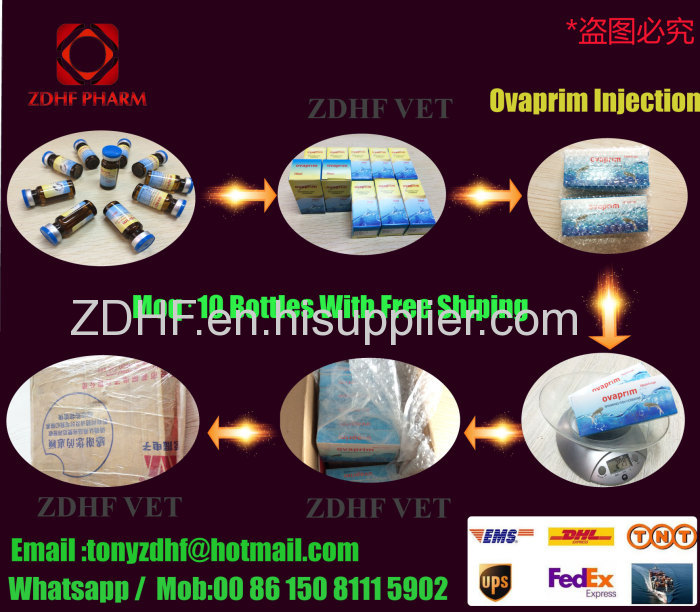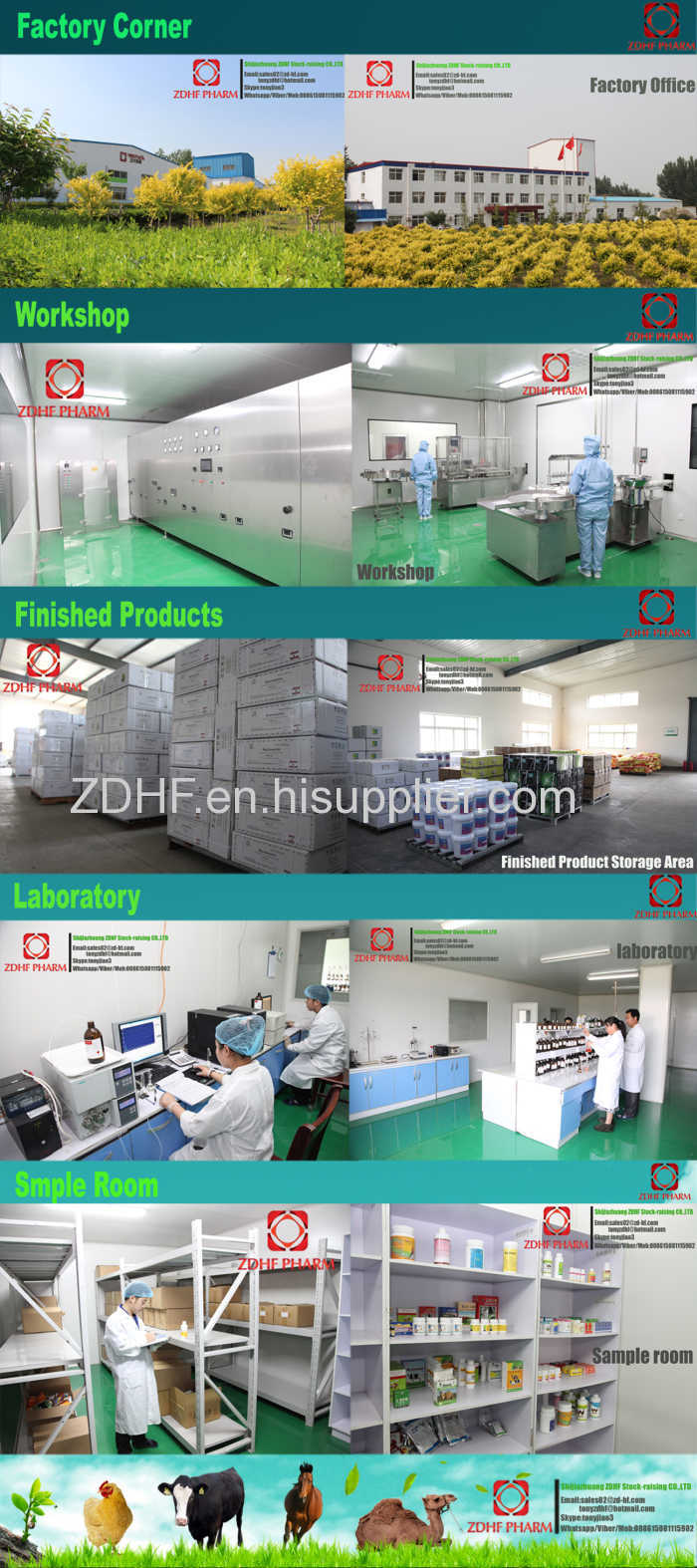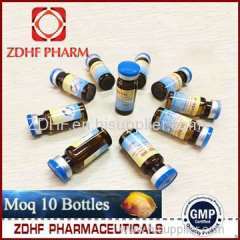
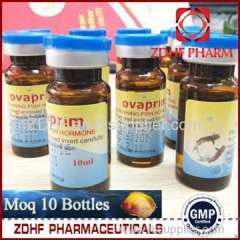
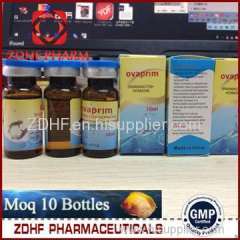
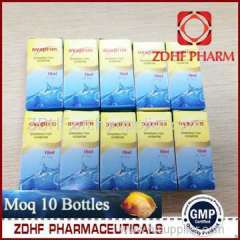
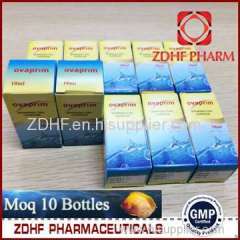
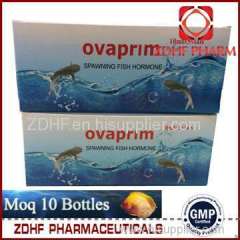
Aquaculture Breeding Spawn Hormone Ovaprim For Breeding Fish
| Min. Order: | 10000 Piece/Pieces |
|---|---|
| Payment Terms: | L/C, D/P, D/A, T/T, WU |
| Supply Ability: | 10000 |
| Place of Origin: | Hebei |
Company Profile
| Location: | Shijiazhuang, Hebei, China (Mainland) |
|---|---|
| Business Type: | Manufacturer |
| Main Products: | Veterinary Medicine |
Product Detail
| Model No.: | Ovaprim Injection |
|---|---|
| Means of Transport: | Ocean, Air, Land |
| Dosage Form: | Injection |
| Type: | Drug |
| Brand Name: | ZDHF Vet |
| Component: | Fish Spawning Medicine |
| Function: | Booster Supplement |
| Product Name: | Ovapirm Injectable |
| Composition: | Spawn Injection |
| Type: | Fish Medicine |
| GMP: | Yes |
| Brand Name: | OEM OR ZDHF |
| Provide Samples: | Yes |
| Registratioin: | Support |
| Price: | Pls contact me |
| Skype: | tonyjiao3 |
| Cell/Viber/Whatsapp: | 008615081115902 |
| Production Capacity: | 10000 |
| Packing: | as your request |
| Delivery Date: | 15days |
Product Description
How is spawning triggered naturally?
Spawning, the release of gametes (mature oocytes/eggs by the female or of sperm/milt by the male) from the gonads (ovaries or testes), is the final event in the reproductive cycle (Rottmann et al. 1991a), and is the result of complex interactions between a variety of hormones and different tissues/organs in the fish's body.
The following description is a very simplified version of major events (Rottmann et al. 1991a; Figure 1a) that occur during natural spawning. Environmental and internal factors (which differ from species to species) trigger a hormone cascade leading to egg maturation and release in females, and sperm maturation and release in males. First, a hormone called "gonadotropin-releasing hormone" (GnRH) is released from the hypothalamus portion of the brain and travels to the pituitary gland, which then releases gonadotropin hormones (especially GtH-II). The gonadotropin hormones/GtH-II travel to the ovaries and testes and stimulate them to produce steroids and prostaglandins, hormones that act directly on the gonads to cause final maturation and release of oocytes ("eggs") in females (ovulation), and the release of sperm in males (spermiation) (Rottmann et al. 1991a; Evans and Claiborne 2006). In some species of fish, a compound called dopamine naturally blocks this hormone cascade and inhibits egg and sperm production under certain conditions, for example, exposure to major stressors.
What is Ovaprim?
Ovaprim is a two-part drug consisting of 1) a shorter, synthetic version of GnRH and 2) domperidone. Ovaprim is marketed ready to inject in a liquid form.
In the ornamental fish industry, Ovaprim is used as a spawning aid to induce ovulation (release of mature oocytes/eggs) and spermiation (release of milt/sperm) in mature, properly conditioned brood-fish. Ovaprim is especially useful for species for which natural spawning in captivity is difficult to induce.
NOTE: Use of Ovaprim does not guarantee successful fertilization, development, and hatch of fry. Overall good husbandry and hatchery management, including good genetics, proper nutrition, environment (including water quality), substrates, social structure, and other factors will affect egg and milt quality, egg hatch, and fry survival.
How does Ovaprim work?
For some ornamental species, determining which natural environmental cues will lead to ovulation and spermiation has been difficult. Ovaprim's synthetic GnRH closely resembles that of naturally occurring GnRHs and, in many species, is actually more potent (Figure 1b). When injected into the body cavity (coelom or abdomen) or muscle of receptive, mature, conditioned fish, the synthetic GnRH travels from the injection site through the blood to activation sites in the pituitary gland. Ovaprim initiates the reproductive cascade and eliminates the need for a natural trigger. Domperidone, the other active component of Ovaprim, helps block the inhibitory effects of dopamine. Domperidone, therefore, is very important for induced spawning of species for which the reproductive cascade would be stopped because of stressors that lead to dopamine release, because dopamine will block GnRH activity.
How do I check my fish for maturity?
For many fish species, sex determination is based on the differences in coloration or body shape. In species where males and females look similar, one crude method that is often useful to determine sex of the fish is based on the larger volume of the eggs in conditioned females vs. sperm in males. Females may become more robust around the coelomic cavity (from enlarged ovaries due to egg yolk accumulation in late stages). In some cases, more robust fish may in fact be fat males. Consequently, careful collection and examination of eggs from the ovary (or sperm from the testes) is highly recommended for a more accurate assessment.
What supplies do I need to use Ovaprim?
Tank(s) with aerated water for sedation
Tank(s) with aerated water for recovery
Sedative.
Syringes with permanently attached needles or with luer lock tips and separate needles (22–28 gauge)
For smaller fish (100 grams or less), use of microliter (μL ) syringes with smaller gradations (typically 100 μL volume divided into 1 μL increments) and with screw-on needles will make administration simpler.
What else should I know before I use Ovaprim?
Because Ovaprim is a viscous liquid, the use of a syringe with a luer lock tip or permanently attached needle is recommended. Slip-on type needles may eject from the pressure, so if you use them, be sure they are seated on the syringe tightly.
To avoid introduction of bacteria or other pathogens via injection, use only sterile needles and syringes to withdraw Ovaprim from the bottle, and to inject the fish. After withdrawing the correct amount required for the specific fish, carefully point the syringe and needle upward and depress the syringe to remove any excess air.
Where do I inject the fish?
First, immobilize the fish using the correct dose of an anesthetic (e.g., tricaine methanesulfonate ["MS-222"] or metomidate). Fish should be injected either in the muscle (IM) or in the body cavity (IP or ICe; i.e., in the "peritoneal cavity" or coelomic cavity) (see figures 2 and 3 ). If you are injecting into the muscle (IM), a good area in many species is the dorsal (top) area of the fish, immediately behind or near the dorsal fin. If you are following a two-injection protocol, site the two injections on opposite sides of the fish. If you are injecting the fish into the body cavity (IP or ICe), turn it so that its ventral surface (belly) is up and its posterior (back ) end is slightly elevated. Inject into the body cavity in an area that is forward of but slightly off center to the anus or vent, and be sure not to go too deep. If you make the injection too deep, you may accidentally inject into internal organs rather than into the body cavity itself.
How should I store Ovaprim?
Store below 77°F (25°C) and protect from sunlight and sources of heat.


